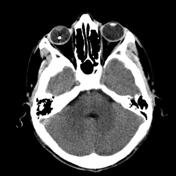Items tagged “eye”
103 results found
Article
Lacrimal gland masses
Lacrimal gland masses can be classified into two broad groups - inflammatory (~50%) and neoplastic, either lymphoma (25%) or salivary gland type tumors (~25%).
Pathology
Inflammatory
sarcoidosis
affects ~25% of patients with systemic disease
orbital inflammatory pseudotumor
lacrimal glan...
Case
Bilateral macular calcification

Published
19 Dec 2010
68% complete
CT
Case
Intraocular metal splinter

Published
08 Jul 2011
74% complete
CT
Article
Proptosis
Proptosis (rare plural: proptoses) refers to forward protrusion of the globe with respect to the orbit. Proptosis can be relative (to the contralateral eye), comparative (to a prior measurement of the same eye), or absolute (based on normal population reference values).
Terminology
Exophthalmo...
Case
Orbital pseudotumor

Published
26 Jul 2013
71% complete
MRI
Article
Orbital septum
The orbital septum (plural: orbital septa) is a thin sheet of fibrous tissue that originates from the orbital rim periosteum and blends with the tendon of the levator palpebrae superioris superiorly and inserts into the tarsal plate inferiorly.
The orbital septum separates the intra-orbital fat...
Article
Nasolacrimal drainage apparatus
The nasolacrimal (drainage) apparatus consists of:
lacrimal canaliculi
lacrimal sac
nasolacrimal duct
Gross anatomy
Tears produced by the lacrimal gland, accessory lacrimal glands of Krause, Wolfring and Zeis, and Meibomian glands track medially along the eyelid margins and collect at the l...
Article
Lacrimal apparatus
The lacrimal apparatus consists of the lacrimal gland and the nasolacrimal drainage apparatus.
The gland produces tears secreted into the lateral aspect of the superior fornix. The serous fluid washes over the eye and is drained at the medial canthus by the superior and inferior lacrimal canal...
Article
Lacrimal canaliculi
The lacrimal canaliculi form the first part of the nasolacrimal drainage apparatus that drains tears produced by the lacrimal gland.
Gross anatomy
There are two lacrimal canaliculi - superior and inferior on each side. They commence at the superior and inferior lacrimal puncta, which drain te...
Article
Nasolacrimal duct
The nasolacrimal duct (NLD) is the terminal part of the nasolacrimal apparatus.
Gross anatomy
The nasolacrimal duct is the inferior continuation of the lacrimal sac and is ~17 mm in length in total. The duct runs in the bony nasolacrimal canal. There are two parts to the nasolacrimal duct:
in...
Case
Globe rupture (anterior chamber)

Published
28 Mar 2014
62% complete
CT
Article
Optic neuropathy
Optic neuropathy is a broad term and can result from a variety of causes.
Pathology
genetic
Leber hereditary optic neuropathy
compression or trauma (traumatic optic neuropathy)
optic nerve sheath meningioma
progressive diaphyseal dysplasia
thyroid-associated orbitopathy
shear injury
inf...
Article
Optic neuritis
Optic neuritis denotes inflammation of the optic nerve and is one of the more common causes of optic neuropathy. It can be thought of as broadly divided into infectious and non-infectious causes, although the latter is far more frequent. On imaging, optic neuritis is most easily identified as a ...
Article
Chorioretinal lacunae
Chorioretinal lacunae refer to punched out lesions in pigmented layer of retina, usually around the optic disc. It is a considered a consistent feature of Aicardi syndrome.
Case
Orbital pseudotumor

Published
28 Nov 2014
83% complete
CT
Case
Orbital floor fracture with ruptured globe

Published
16 Jan 2015
95% complete
CT
Case
Phthisis bulbi and posterior staphyloma

Published
07 Feb 2015
83% complete
CT
Article
Congenital cataract
Congenital cataracts are a major cause of blindness with early detection the most important factor in reducing impact on future vision.
Epidemiology
Incidence is ~3 per 100,000 in the United Kingdom 1. Although the incidence tends to be higher in areas with increased rates of congenital infec...
Article
Enlarged extraocular muscles (differential)
There is a short list of causes for enlarged extraocular muscles. The differential can be narrowed by the clinical history, known systemic illness, pattern of specific muscles involved, the muscle morphology, as well as concurrent findings outside the muscles 3:
inflammatory, infectious, and de...
Article
Asteroid hyalosis
Asteroid hyalosis is a degenerative condition of the eye where there is an accumulation of calcium soaps in the vitreous chamber.
Epidemiology
The prevalence increases with age from 0.2% in 43-54 year-olds to 2.9% in 75-86 year-olds. The overall prevalence is 1.2%. It is commonly unilateral an...







 Unable to process the form. Check for errors and try again.
Unable to process the form. Check for errors and try again.